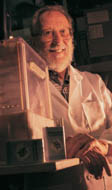 Waiting to exhale At a small lab in a nondescript building outside UC Davis, research assistants stuff cigarettes into a chambered wheel that emits puffs as it turns. With one crank of the wheel, 10 little puffs of smoke escape. It's odd to catch a whiff of burning tobacco in this institutional setting where all smoking is banned, but certainly no odder than watching a machine smoke the equivalent of two cartons of cigarettes a day. The smoke-filled air is headed - in concentrations that would be familiar to airline stewardesses and bartenders of yore - into the rooms of a breed of mice known for their special ability to develop lung tumors. The experiment is designed to simulate the effects of smoking on mice, "which mice are too smart to do," says Hanspeter Witschi, associate director of the Institute for Toxicology and Environmental Health. "In early experiments scientists blew smoke into their cages, but the animals would hold their breath." This machine - and the research it's used for - helps Witschi observe the effects of secondhand smoke in laboratory animals and, by association, in people. It's an area of study that has piqued the attention of public health officials, occupational health and safety agencies and legislators for more than three decades.
Home |
Table of Contents |
To our Readers |
Building on Basics UC Davis Health System | © 2000, 2001, 2002 UC Regents. All rights reserved. |
Cereal brans and asthma drugs offer important clues in the quest to prevent lung cancer in smokers. |

